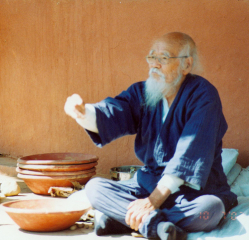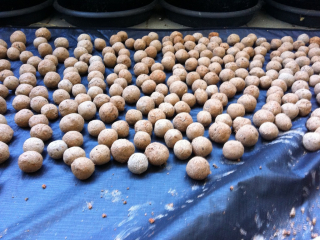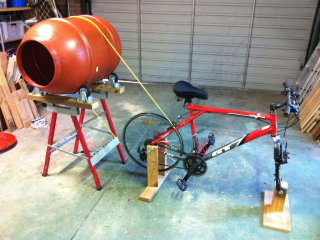Seed balls are an ingenious idea, developed and pioneered by Masanobu Fukuoka. Fukuoka was a Japanese farmer and philosopher, and an early proponent of natural farming. He suggested that much of the effort that humans put into agriculture is wasted, and that we should instead be working with the natural environment. Seed balls are one way of doing that.
Fukuoka wrote “If rice is sown in the autumn and left uncovered, the seeds are often eaten by mice and birds, or they sometimes rot on the ground, and so I enclose the rice seeds in little clay pellets before sowing. The seed is spread out on a flat pan or basket is shaken back and forth in a circular motion. Fine powdered clay is dusted over them and a thin mist of water is added from time to time. This forms a tiny pellet about a half-inch in diameter. There is another method for making the pellets. First, the unhulled rice seed is soaked for several hours in water. The seeds are removed and mixed with moist clay by kneading with hands or feet. Then the clay is pushed through a screen of chicken wire to separate it into small clods. The clods should be left to dry for a day or two or until they can be easily rolled between the palms into pellets. Ideally, there is one seed in each pellet. In one day it is possible to make enough pellets to seed several acres. Depending on conditions, I sometimes enclose the seeds of other grains and vegetables in pellets before sowing.” (Masanobu Fukuoka [1978]. The One-Straw Revolution, p.99.)
It’s a very simple idea. Seed balls are simply scattered directly onto the ground, and not planted, which provides a huge reduction in the time and effort to plant any large area. The clay protects the seeds from birds, insects, and harsh weather conditions until enough rain falls to melt the clay and germinate the seeds. The seed ball contains a mixture of different seeds, and their planting is left to the elements and random selection, so that the most appropriate plant in the most appropriate position will emerge, and require the least attention. Seeds can be mixed to form deliberate companion planting guilds, or a variety of seeds can be included to ensure a varied ecosystem results. Many people include chilli powder, mint, or pennyroyal to repel ants from digging the seeds out of the seed balls, and you can also add inoculant for legumes and the spores of mycorrhizal fungi to encourage a healthy soil ecosystem from the start.
We tried an initial round of seed ball making, using 1 part seeds to 3 parts vermicompost, 1 part chilli powder, 5 parts bentonite clay with added minerals, and approximately 2 parts water. Red clay powder is hard to get here, and the only benefit in using red clay over bentonite is the mineral content. Conclusion: hand rolling around 600 seed balls takes a long time, and it gets really easy to roll them too big. It was fun, but I think it would quickly get to be less fun considering that for our 7.5 acres we expect to need something like 300,000 seed balls (at a recommended application rate of ten seed balls per square metre, or more to reclaim derelict land.).
Automation beckoned as a solution. The internet abounds with ideas and designs for machines for making seed balls. The basic premise is a barrel or drum and a mechanism to roll it in place. The dry seed ball mix is introduced into the rolling drum, and water is sprayed onto the dry mix until it begins to nucleate and form small balls. A mesh screen is used to catch seed balls once they reach a certain size and remove them from the drum.
The machine is simple and straightforward, and we would have gone ahead and built one with a motor to roll the barrel, just like all the rest on the internet, except that I saw Milkwood Permaculture’s bicycle powered machine. It’s ingeniously low tech, and can run anywhere without needing a battery or an electricity outlet. As far as I can tell, it’s also the only bicycle powered seed ball machine anywhere (or at least, the only one on the internet). Until now.
One recycled bicycle frame, modified plastic olive barrel (also recycled, and thoroughly cleaned of olive flavoured brine), some wood and stretchy rope later – we have The Machine. It hasn’t yet had its inaugural use, but it spins perfectly. Watch this space for updates.



HAHAHAHAHAHA BALLS <3 <3
I am very interested in making these is there an update on this machine?
It worked pretty well actually. Still need to get the mix exactly right. We lack much clay in our soil here. However even as a method to create initial loose balls to finish manually it’s an amazing time saver!
We’ll be making one of these this spring. I wonder how yours steers. 😉 Excellent work and thanks for sharing. How ’bout some pictures of the green rewards of your ingenuity!
Is there any issue with slippage? Since the barrel and the drive are not attached to the same frame? One thing I would like is to configure the machine so that it can be operated by one person.
What are your observations on the rotational rate of the barrel? Some other bike/seed-ball tumblers use the sprocket around the pedals rather than the wheel to turn the barrel, which would provide a very different effect.
We find the rotation to be pretty good.. it’s a nice slow roll. Makes good clumping so far. We were thinking it would slip lots at first but even with a large amount of dirt in the barrel it continues to turn fine. The cord we’re using from the wheel to the barrel is slightly elastic so when we pull it tight it has a bit of give. We found this is totally adequate to provide the grip needed to keep it going. If you REALLY peddle hard suddenly it will rotate without turning the barrel for one spin but a nice steady pedal and it’s all go.
Thanks for the detailed follow up. Very useful information! Good to hear it works so well for you. Makes me feel encouraged that we’ll meet our mechanization needs witj success!